#Extinct Ammonoid
Explore tagged Tumblr posts
Photo
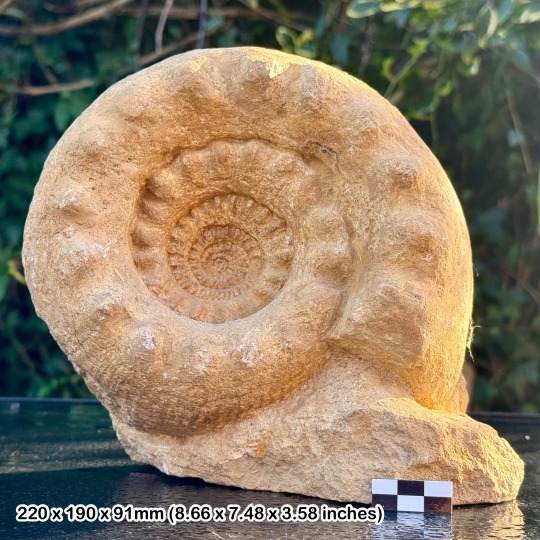
RARE 7" Teloceras banski Fossil Ammonite – Upper Bajocian Jurassic – FROGDEN OBORNE, Dorset, UK – Genuine + COA!
RARE: 7" Teloceras banski Fossil Ammonite – Upper Bajocian, Jurassic – FROGDEN OBORNE, Dorset, United Kingdom
📜 From the Prestigious Alice Purnell Collection! 📜
✅ 100% Genuine Specimen – Comes with a Certificate of Authenticity (COA)
📏 Scale Rule / Cube = 1cm (Full sizing details in photos)
📸 You will receive the exact fossil shown in the images
🦑 Fossil Overview:
This is a RARE and well-preserved 7" Teloceras banski Fossil Ammonite from the Upper Bajocian Stage in the Jurassic Period (~168 million years old), sourced from Frogden Oborne, Dorset, United Kingdom. Teloceras is a genus of extinct ammonoid cephalopods, recognized for its coiled, ribbed shell and distinct suture patterns, making it a remarkable specimen for fossil collectors.
Teloceras ammonites are known for their evolute coiling and prominent ribbing, providing insight into Jurassic marine biodiversity. This particular specimen showcases exceptional preservation, with detailed shell structure and well-defined growth lines.
This fossil originates from the Alice Purnell Collection, one of the largest and most renowned ammonite and cephalopod fossil collections in the world. Fossils from this collection are highly sought after, ensuring this piece holds both scientific and historical significance.
🪨 Geological & Scientific Details:
Species: Teloceras banski
Group: Ammonoid Cephalopod
Age: Jurassic (Middle Jurassic, Upper Bajocian Stage, ~168 Million Years Ago)
Formation: Marine Deposits of Frogden Oborne
Location: Frogden Oborne, Dorset, United Kingdom
Size: 7 inches
Shell Features: Prominent ribbing, evolute coiling, and distinct suture patterns
Preservation: Excellent condition with visible fine details and natural fossilization patterns
Teloceras ammonites were active marine predators, using their coiled shells for buoyancy control. Their widespread distribution in Jurassic seas makes them an essential index fossil for dating marine sediments.
🛒 Why Buy This Fossil?
✔ RARE 7" Teloceras banski specimen – Sourced from Frogden Oborne, Dorset
✔ Prestigious Alice Purnell Collection provenance – Highly collectible
✔ Authentic Jurassic Fossil – 168-million-year-old prehistoric relic
✔ Perfect for Collectors, Museums, and Educational Displays
✔ 100% Genuine & Certified Fossil – Comes with a Certificate of Authenticity (COA)
✔ Great Investment Piece – Fossils of this rarity and quality are only increasing in value
📦 Shipping & Packaging:
Securely packed to ensure safe arrival
Tracked & insured shipping for peace of mind
Worldwide shipping available! 🌍
🔬 Don’t miss out on this scientifically significant, rare fossil! Perfect for serious collectors, museums, or as a unique display piece.
📥 Buy with confidence – 100% authentic, fully certified, and ready to ship!
🔎 Check out our other fossils & rare specimens!
🔥 RARE 7" Teloceras banski Fossil Ammonite – Once it’s gone, it’s gone! 🔥
#Fossil Ammonite#Teloceras banski#Jurassic Fossil#Upper Bajocian Fossil#Ammonite Fossil#Cephalopod Fossil#Paleontology#Fossil Collector#Prehistoric Sea Life#Extinct Ammonoid#Rare Fossil#Authentic Fossil#Geological Specimen#Museum Fossil#Alice Purnell Collection#Frogden Oborne Fossils#Dorset Fossils#UK Fossils
0 notes
Text
SIDELINED SEASHELLS: REAPPRAISAL OF THE MIDDLE TRIASSIC AMMONOIDS OF SAMOBOR AND ŽUMBERAK MTS. (NORTH-WESTERN CROATIA) AND THEIR SYSTEMATICS AND BIOSTRATIGRAPHIC IMPLICATION
Published 7th September 2023
Ammonoid fossils from the Basinal Middle Triassic of the Samobor and Žumberak Mts in north-western Croatia are formally described and identified, revealing an impressive range of diversity within the region.
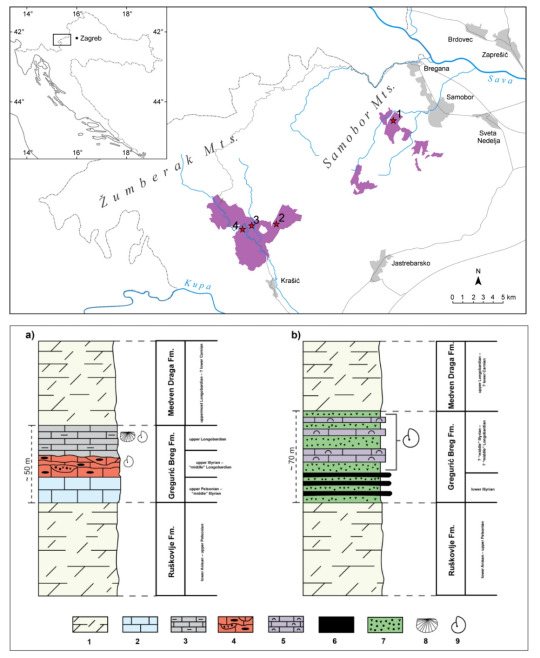
Topographic map of the Samobor and Žumberak Mts. area, The schematic stratigraphic columns of the localities of interest (1-late diagenetic dolostone, 2- shallower-water thick-bedded limestone, 3- thinly bedded, marly limestones, with occasional occurrences of chert and pyroclastic rocks, 4- grey to red nodular silicified limestone with lenses/layers of ammonitic limestone and pyroclastic rocks, 5- bedded hemipelagic limestone with cephalopods and juvenile pelagic bivalves, 6- radiolarian chert, 7- pyroclastic rocks, 8- occurrence of the bivalve Daonella, 9- occurrence of ammonoids)
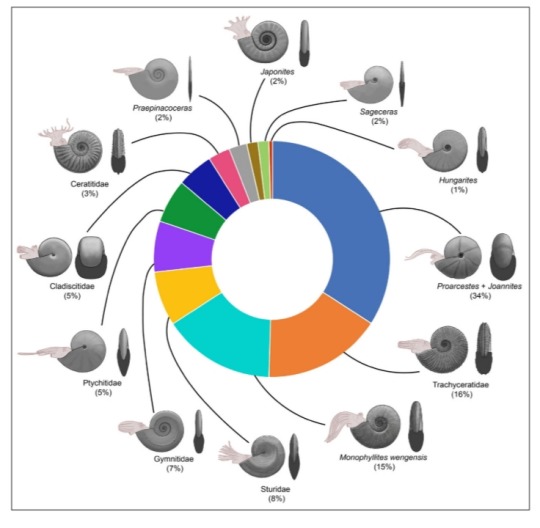
Proportion of the ammonoid taxa from the historic collections of the relevant institutions


A list of examined ammonoid taxa collected from the red nodular limestone facies of the Gregurić Breg locality, A list of known ammonoid taxa collected at multiple neighbouring localities in the Žumberak Mts
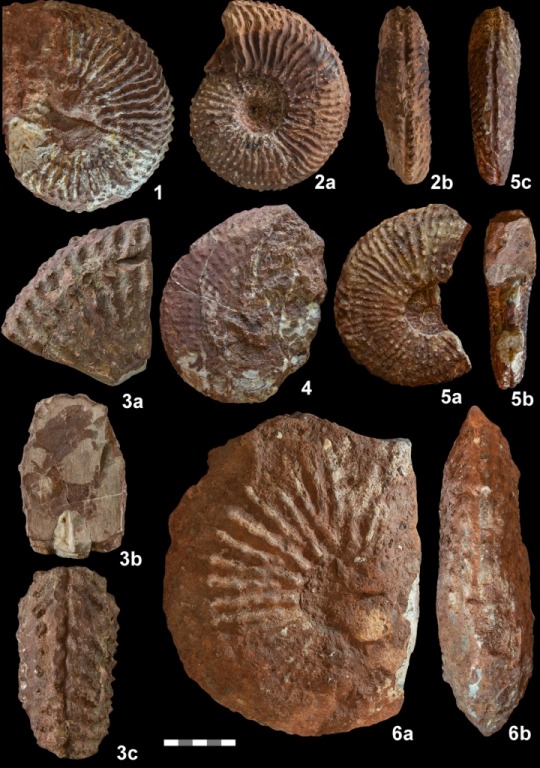
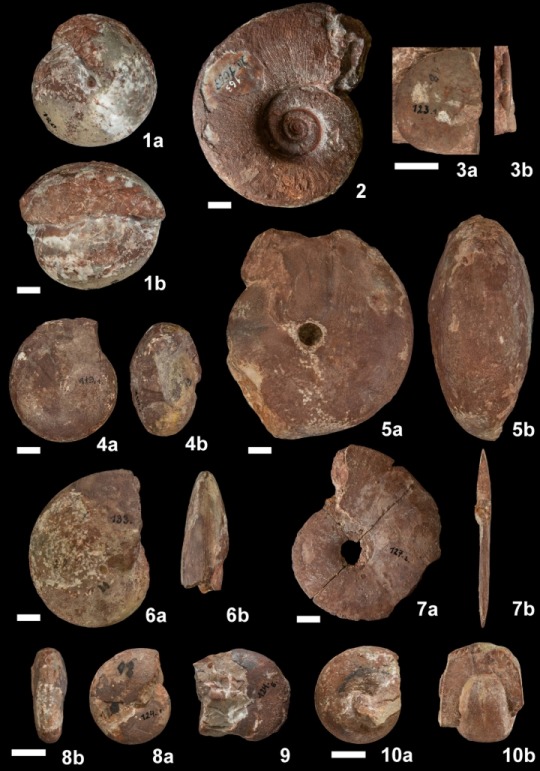

examples of the described ammonoid fossils
source:
9 notes
·
View notes
Text
Round 3 - Cephalopoda - Nautilida




(Sources - 1, 2, 3, 4)
Order: Nautilida
Common Name: “nautilus” (pl: “nautiluses” or “nautili”)
Families: 1 - Nautilidae
Anatomy: Smooth external shells with internal chambers, 50-90+ tentacles, toothed radula within parrotlike beak
Diet: crustacean molts, hermit crabs, carrion
Habitat/Range: Indo-Pacific ocean, at depths of several hundred metres
Evolved in: Order Nautilida in the Devonian, Family Nautilidae in the Triassic (230 million years ago)
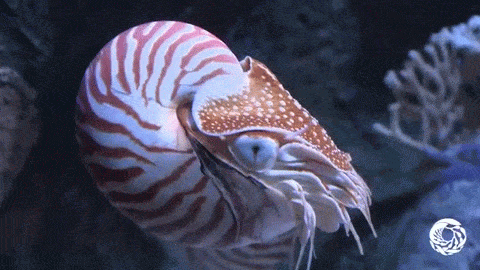
Propaganda under the cut:
During the Middle Devonian, Nautilus species were more diverse, and their shells were more varied than those found in species of living Nautilus, ranging from curved (cyrtoconic), through loosely coiled (gyroconic), to tightly coiled forms, represented by the Rutoceratidae, Tetragonoceratidae, and Centroceratidae. Only a single genus, Cenoceras, with a shell similar to that of the modern nautilus, survived the Triassic extinction, at which time the entire Nautiloidea almost became extinct. They diversified again, but never reached the extent of diversity they had before the Triassic extinction. The nautilids were not as affected by the end Cretaceous mass extinction as the Ammonoids that became entirely extinct, possibly because their larger eggs were better suited to survive the conditions of that environment-changing event.
Nautiluses are the sole living cephalopods to have external shells. They can withdraw completely into their shell and close the opening with a leathery hood formed from two specially folded tentacles.
The nautilus has the extremely rare ability to withstand being brought to the surface from its deep natural habitat without suffering any apparent damage from the experience. Where fish or crustaceans brought up from such depths inevitably arrive dead, a nautilus will be unfazed despite the pressure change of as much as 80 standard atmospheres (1,200 psi).
Nautiluses have a seemingly simple brain, lacking the large complex brains of octopus, cuttlefish and squid, and had long been assumed to lack intelligence. But recent experiments have shown not only memory, but a changing response to the same event over time.
In a study in 2008, a group of Chambered Nautiluses (Nautilus pompilius) were given food as a bright blue light flashed until they began to associate the light with food, extending their tentacles every time the blue light was flashed. The blue light was again flashed without the food 3 minutes, 30 minutes, 1 hour, 6 hours, 12 hours, and 24 hours later. The nautiluses continued to respond excitedly to the blue light for up to 30 minutes after the experiment. An hour later they showed no reaction to the blue light. However, between 6 and 12 hours after the training, they again responded to the blue light, but more tentatively. The researchers concluded that nautiluses had memory capabilities similar to the "short-term" and "long-term memories" of the more advanced cephalopods, despite having different brain structures.
Female nautiluses spawn once per year and regenerate their gonads, making nautiluses the only cephalopods to be able to breed more than once in their lifetime.
Nautiluses may live for more than 20 years, which is exceptionally lengthy for a cephalopod, many of whom live less than 3 even in captivity and under ideal living conditions. However, nautiluses typically do not reach sexual maturity until they are about 15 years old, limiting their reproductive lifespan to often less than five years.
The osmeña pearl is not actually a pearl, but a jewellery product derived from the iridescent inner layer of the nautilus shell. Nautilus shells are also sold whole, carved as souvenirs, or historically used to make items such as lamps and cups. However, these are not simply shells that wash ashore; the animals are killed for the shell. The low fecundity, late maturity, long gestation period, and long life-span of nautiluses make them vulnerable to overexploitation, and high demand for their ornamental shells is causing population declines. In 2016 all species in the family Nautilidae were added to CITES Appendix II, regulating international trade, though in some places they can still openly be found for sale in tourist areas. The best way to combat nautilus population decline is to stop the demand for these shells.
#animal polls#I’m not gonna lie I have 1.5 nautilus shells in my house 😓#bought them when I was young and before nautiluses were protected#I know better now of course but they’re just… here… on my shelf of skulls and stuff#If you want one I suggest looking in antique and thrift shops so you’re not directly funding nautilus poaching!#don’t buy them from shell shops and other tourist attractions#or Etsy#Round 3#Cephalopoda#Nautilida
121 notes
·
View notes
Note
for the hc thingy 🐈 pls! but nopt related to the pets in game! irl pets/animal ones!!
❄️ Schneeball is quite fond of aquarium-keeping in her spare time - fish, shrimp, sea snails, and so forth, as well as a number of extinct specimens that she’s able to feasibly take care of in such an environment (namely trilobites and ammonoids) with appropriate permission from her manager.
🍞 Marble is decidedly a dog person, of course, but most animals have a tendency to just adore him in general. He’s relaxed and gentle by nature, and has a very calming aura to him. He’s also got quite a bit of experience with grooming the other agents’ pets - it helps a lot that he’s far from squeamish.
6 notes
·
View notes
Note
🧡 color you can't stand & 🦖 favorite extinct animal?
hi elijah 😊
Hmmm I can't really think of colors themselves I can't stand other than I'm tempted to say White because of contexts in which that shit is too reflective/bright. But that kinda isn't the color itself...
I do find like cyclically I get so fucking pissed at Color Palettes because they reappear in dogshit product I have to stock/organize like ok that reminds me I wanted to make a post earlier about how being surrounded with Commodities makes me lose my fucking mind like if I don't have sufficient time in surroundings that I recognize as being like. idk. built off the interiority of a unique human being I give a shit about I get sooo fucking reductive and cynical about how everyone is just mindless fucking sheep that don't even know how to desire something without a market being made for it and everything pisses me off. which is like. yeah that sure is an opinion someone who is feeling like all of reality is the same fucking supermarket would have and is not like. true.


like look at this fucking shit. extrapolate ig I'm surrounded by this shit for hours and i have to interface with it and facilitate it being sold
but like more to the point i was Pissed The Fuck Off at the pastel colors of these candles for a while


coz we were doing a sort of back to school focused thing for college students that would be moving [back] into the area so yknow we were told to expect an influx of people wanting to buy shower curtains, furniture, or um idk random basics like plungers, and decor. so for a while we had a decor aisle for this purpose that had a buncha shit in these sort of colors, with some of them being corny ass Block Texts or LED signs that said, idfk, Vibes. probably some of that shit pissed me off a la Gay Water Racism Is Small Dick Energy. but yeah anyway I was like Tch... about these colors for representing. something. about all of that.
Favorite extinct animal in terms of fossil I'd say is ammonoids but other than that maybe either trilobites or the Ankylosaurus
1 note
·
View note
Text
#2775 - Paranorites sp.

Ammonites from around 252 - 247 Mya, straddling the border of the Permian and Triassic. I have no idea why this genus survived the worst mass extinction event in Earth's history when so many others didn't.
The earliest ammonoids appeared during the Early Devonian, and the last species vanishing 353 million years later during or soon after the Cretaceous–Paleogene extinction event. They were named by Pliny the Elder, who comparred the fossils to the ram's horns of the Egyptian god Amun. For the same reason, many ammonite genera end in -ceras, meaning "horn". The smallest known ammonites were Maximites, only 10mm in diameter. The largest was Parapuzosia seppenradensis, 200 times that.
Very little is known about the soft tissues of Ammonites - no soft tissue fossils were confirmed until 2021. All species were either predators or filter feeders.
In medieval Europe, fossilised ammonites were called "snakestones" or "serpentstones" and carved or painted to match the folkore.
University of Otago Geology Museum, Dunedin, Aotearoa New Zealand.
#Paranorites#Paranoritidae#University of Otago Geology Museum#Dunedin#Dunedin NZ#new zealand fossil#fossil#ammonite
0 notes
Text
The Look Into the Most Common Fossils Found in North American Sedimentary Rocks?
North America’s fossil record chronicles over 3 billion years of dramatic prehistoric life. Spanning extinct marine reptiles to Ice Age saber-tooths, North American strata have yielded some of paleontology’s most storied discoveries. In this blog, we highlight the most common fossils buried within the rocky layers of this fossil-rich continent. These extinct cephalopods dominated Mesozoic marine ecosystems for over 340 million years. Ammonoids left behind abundantly fossilized coiled shells. Read more: https://www.fossilageminerals.com/blogs/news/the-look-into-the-most-common-fossils-found-in-north-american-sedimentary-rocks

0 notes
Photo

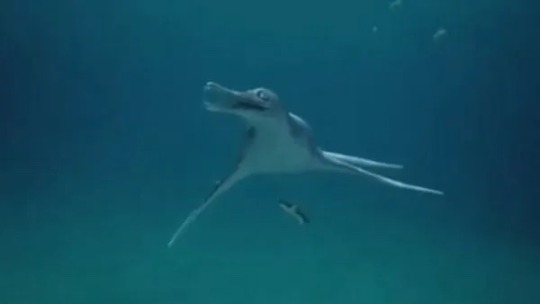
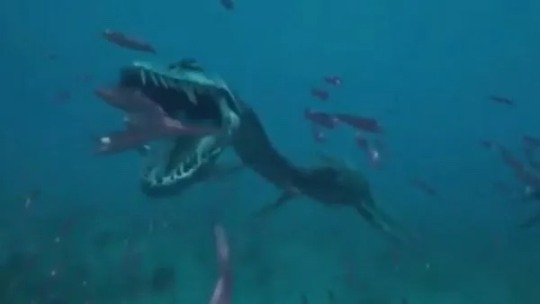


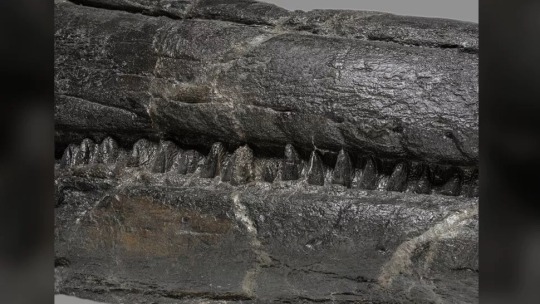


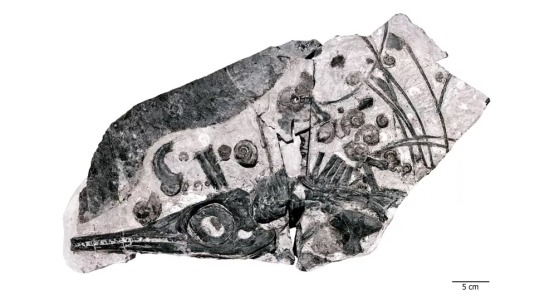
55-foot-long Triassic Sea Monster Discovered in Nevada
The beast shows that ichthyosaurs grew big really fast.
A sea monster that lived during the early dinosaur age is so unexpectedly colossal, it reveals that its kind grew to gigantic sizes extremely quickly, evolutionarily speaking at least.
The discovery suggests that such ichthyosaurs — a group of fish-shaped marine reptiles that inhabited the dinosaur-era seas — grew to enormous sizes in a span of only 2.5 million years, the new study finds. To put that in context, it took whales about 90% of their 55 million-year history to reach the huge sizes that ichthyosaurs evolved to in the first 1% of their 150 million-year history, the researchers said.
"We have discovered that ichthyosaurs evolved gigantism much faster than whales, in a time where the world was recovering from devastating extinction [at the end of the Permian period]," study senior researcher Lars Schmitz, an associate professor of biology at Scripps College in Claremont, California, told Live Science in an email. "It is a nice glimmer of hope and a sign of the resilience of life — if environmental conditions are right, evolution can happen very fast, and life can bounce back."
Researchers first noticed the ancient ichthyosaur's fossils in 1998, embedded in the rocks of the Augusta Mountains of northwestern Nevada. "Only a few vertebrae were sticking out of the rock, but it was clear the animal was large," Schmitz said. But it wasn't until 2015, with the help of a helicopter, that they were able to fully excavate the individual — whose surviving fossils include a skull, shoulder and flipper-like appendage — and airlift it to the Natural History Museum of Los Angeles County, where it was prepared and analyzed.
The team named the new species Cymbospondylus youngorum, they reported online Thursday (Dec. 23) in the journal Science. This big-jawed marine reptile lived 247 million years ago during the Triassic period. Like other creatures from that time, it was weird. "Imagine a sea-dragon-like animal: streamlined body, quite long, with limbs modified to fins, and a long tail," Schmitz said. With a nearly 6.5-foot-long (2 meters) skull, this full-grown C. youngorum would have measured over 55 feet (17 m), or longer than a semitrailer, the researchers found.
When the 45-ton (41 metric tons) C. youngorum was alive, C. youngorum would have lived in the Panthalassic Ocean, a so-called superocean, off the west coast of North America, Schmitz said. Based on its size and tooth shape, C. youngorum likely ate smaller ichthyosaurs, fish and possibly squid, he added.
There are many huge beasts that lived during the dinosaur era, but C. youngorum stands out for several reasons. For instance, C. youngorum lived just 5 million years after "the Great Dying," a mass extinction event that occurred 252 million years ago at the end of the Permian period, which killed about 90% of the world's species. That makes the ichthyosaur's huge size all the more impressive, as it took about 9 million years for life on Earth to recover from that extinction, a 2012 study in the journal Nature Geoscience found.
However, there was a diversification boom of marine molluscs known as ammonoids within 1 million to 3 million years of the mass extinction, the 2012 study found. It appears that ichthyosaurs' venture into gigantism was, in part, due to chowing down on the early Triassic boom of ammonites, as well as jawless eel-like conodonts that filled the ecological void following the mass extinction, the researchers of the new study said. In contrast, whales got big by eating highly productive primary producers, such as plankton; but these were absent in dinosaur-age food webs, study co-author Eva Maria Griebeler, an evolutionary ecologist at the Johannes Gutenberg University of Mainz in Germany, said in a statement.
Despite the whales' and ichthyosaurs' different paths and timetables toward achieving gigantism, the groups have a few similarities. For instance, there is a connection between large size and raptorial hunting, just like sperm whales dive to hunt giant squid, as well as a connection between large size and tooth loss, just like the giant filter-feeding whales that are toothless, the researchers said.
"This new fossil impressively documents the fast-track evolution of gigantism in ichthyosaurs," Schmitz said. In contrast, whales "took a different route to gigantism, much more prolonged and not nearly as fast.
"Ichthyosaur history tells us ocean giants are not guaranteed features of marine ecosystems, which is a valuable lesson for all of us in the Anthropocene," paleontologists Lene Delsett and Nicholas Pyenson, who weren't involved with the research wrote in a related Perspective published in the same issue of Science.
By Laura Geggel.
#55-foot-long Triassic Sea Monster Discovered in Nevada#dinosaur#sea monster#ichthyosaurs#Cymbospondylus Youngorum#archeology#archeolgst#paleontology#paleontologists#history#history news#science#science news
137 notes
·
View notes
Note
Some more extinct suggestions, as I was told off for not naming any invertebrates. No prehistoric sea would be complete without skittering eurypterids ('sea scorpions'), long-stalked feathery crinoids ('sea lillies', cousins of starfish), tentacled ammonoids in coiled shells (altho 'heteromorphs' became insane living knots, like Nipponites), hordes of trilobites (perhaps one with a trident ala Walliserops), and other oddities, like claw-snouted Tully Monster or the giant-eyed Dollocaris.
Thanks for the list.
40 notes
·
View notes
Photo
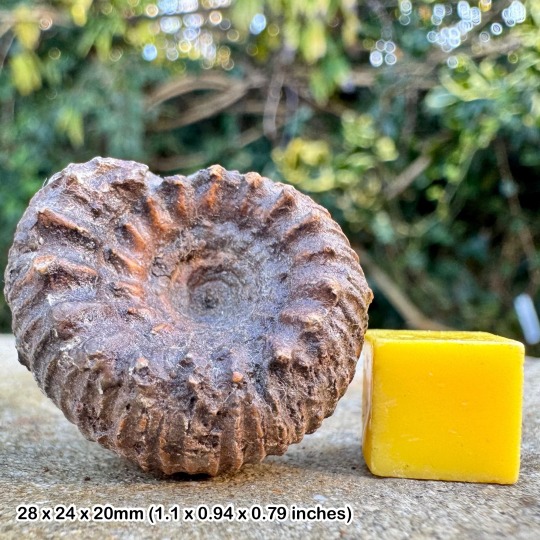
RARE Teloceras primum Fossil Ammonite – Middle Bajocian Jurassic – EYACH, Germany – Genuine + COA!
RARE: Teloceras primum Fossil Ammonite – Middle Bajocian, Jurassic – EYACH, Germany
📜 From the Prestigious Alice Purnell Collection! 📜
✅ 100% Genuine Specimen – Comes with a Certificate of Authenticity (COA)
📏 Scale Rule / Cube = 1cm (Full sizing details in photos)
📸 You will receive the exact fossil shown in the images
🦑 Fossil Overview:
This is a RARE and well-preserved Teloceras primum Fossil Ammonite from the Middle Bajocian Stage in the Jurassic Period (~170 million years old), sourced from Eyach, Germany. Teloceras is a genus of extinct ammonoid cephalopods, recognized for its coiled, ribbed shell and distinct suture patterns, making it a remarkable specimen for fossil collectors.
Teloceras ammonites are known for their evolute coiling and prominent ribbing, providing insight into Jurassic marine biodiversity. This particular specimen showcases exceptional preservation, with detailed shell structure and well-defined growth lines.
This fossil originates from the Alice Purnell Collection, one of the largest and most renowned ammonite and cephalopod fossil collections in the world. Fossils from this collection are highly sought after, ensuring this piece holds both scientific and historical significance.
🪨 Geological & Scientific Details:
Species: Teloceras primum
Group: Ammonoid Cephalopod
Age: Jurassic (Middle Jurassic, Bajocian Stage, ~170 Million Years Ago)
Formation: Marine Deposits of Eyach
Location: Eyach, Germany
Shell Features: Prominent ribbing, evolute coiling, and distinct suture patterns
Preservation: Excellent condition with visible fine details and natural fossilization patterns
Teloceras ammonites were active marine predators, using their coiled shells for buoyancy control. Their widespread distribution in Jurassic seas makes them an essential index fossil for dating marine sediments.
🛒 Why Buy This Fossil?
✔ RARE Teloceras primum specimen – Sourced from Eyach, Germany
✔ Prestigious Alice Purnell Collection provenance – Highly collectible
✔ Authentic Jurassic Fossil – 170-million-year-old prehistoric relic
✔ Perfect for Collectors, Museums, and Educational Displays
✔ 100% Genuine & Certified Fossil – Comes with a Certificate of Authenticity (COA)
✔ Great Investment Piece – Fossils of this rarity and quality are only increasing in value
📦 Shipping & Packaging:
Securely packed to ensure safe arrival
Tracked & insured shipping for peace of mind
Worldwide shipping available! 🌍
🔬 Don’t miss out on this scientifically significant, rare fossil! Perfect for serious collectors, museums, or as a unique display piece.
📥 Buy with confidence – 100% authentic, fully certified, and ready to ship!
🔎 Check out our other fossils & rare specimens!
🔥 RARE Teloceras primum Fossil Ammonite – Once it’s gone, it’s gone! 🔥
#Fossil Ammonite#Teloceras primum#Jurassic Fossil#Middle Bajocian Fossil#Ammonite Fossil#Cephalopod Fossil#Paleontology#Fossil Collector#Prehistoric Sea Life#Extinct Ammonoid#Rare Fossil#Authentic Fossil#Geological Specimen#Museum Fossil#Alice Purnell Collection#Eyach Fossils#Germany Fossils
0 notes
Photo

The Ammonoids The Ammonoids are a subclass of cephalopods that inhabited the oceans from the Devonian some 416 million years ago until they went extinct some 65 million years ago. The species evolved and dispersed rapidly around the world and so are some of the best guide fossils for dating the strata in which they are found.
All these molluscs had an external shell and the structures defined a wide range of different but taxonomically constant forms, allowing identification of the main types, such as goniatitic, ceratitic and ammonitic, according to their complexity. The complexity of the surface was directly related to shell strength, since the more complex it was the more folded was the septum (an internal division in a mollusc shell or a coral) and hence the stronger the shell. This resistance to pressure enabled ammonoids to reduce the thickness of their shell and descend to much greater depths. They could move by jet propulsion, but many of the larger ones probably lived on the seabed. ~ JM Image Credit: https://flic.kr/p/776AyF More Info: http://bit.ly/1HCQmtU
102 notes
·
View notes
Text
I will probably not enter this in the contest I wrote it for, but I’m proud of it anyway.
@aerialsquid, @ardenrosegarden, you will probably like this. It involves ghosts and extinct cephalopods.
The Ordovician Testament
I guess it all started the day we opened a new fracture at the Dakota site. I was a consulting geologist, monitoring pressure gradients in the wellbore while they pumped slurry in to widen the crack.
“We’re about ready to start extracting,” the site manager told me. I nodded.
“You know what the downside is to this process? No fossils.”
“What, like dinosaurs?”
“No, no, we’re in the wrong place for that. See right here,” I pointed to a chart, a map of the wellbore. “We’re right on the edge of the Ordovician shale. The fossils in this layer would be shellfish, trilobites, corals…”
“You collect ‘em?”
“Sort of. But that’s only part of it. Think of what we can learn from them, the picture they paint of the way the world was during that time…”
I could see the manager’s eyes glazing over. He didn’t care that much about geology, as long as it wasn’t working against him. As long as the well kept producing.
At last, the oil started to flow.
“Hell yeah!” The manager grinned. “This is a good one!”
I grinned back. The company had gone out on a limb with this site; my team had been pushing for it, and it had paid off.
I was still thinking about the nice fat end-of-year bonus we’d be getting when my vision started to change. Everything in the monitoring station took on an electric glow. I blinked. It didn’t go away; in fact, it was getting stronger. A faint tension appeared far behind my eyes.
“Hey, Greg, I’m gonna punch out early today. I think I’m getting a migraine.”
The manager glanced back at me. “Yeah, sure. We should be good for a while. Be careful.”
Halfway down the highway, the pain set in. I pulled into the first motel I saw, managed to hold it together long enough to book in, stagger to my room, and collapse.
-------
To this day I haven’t had as bad a headache as that one. I was in that motel room for three days: two of them trying to fight off the pain, the third too wrung-out to move. When my team members called to check on me, they told me to go to the hospital. If I had been thinking clearly, I would have.
As bad as it was, the pain wasn’t the worst part. Whenever I fell asleep, I saw colors. Bright, vivid, solid colors, blinding primaries, rapid-fire pastels, swirling psychedelic neons. It sounds nice, but at the time it was like being kicked repeatedly in the brain. My head was full of colors that gave me no peace and made no sense.
And the mood swings – one minute I was bawling my eyes out, the next, I was ready to rip the lamp out of the wall and throw it across the room. At one point I was up for about twenty-four hours straight, bouncing from rage to depression to manic glee, faintly aware than there was something wrong with me.
About 3 am on the third day of my stay, the pain broke enough to get a coherent thought through, and that thought was that I might have been poisoned. My next thought, which occurred maybe forty minutes later, was that the worst of it was over and I might as well try to get some sleep.
This time, I dreamt of an ocean.
-------
I didn’t have any more symptoms after that, although as soon as I was up I made an appointment to get checked out. Everything came back normal, and the doctor gave me a referral to a neurologist if I kept having migraines. I didn’t call, but I held on to the number. The pain and hallucinations were gone, but I couldn’t shake the feeling that this wasn’t over.
In the following days and weeks, I kept coming back to that thought. Every now and then, my head would fill up with colors again. And I kept dreaming about oceans. Not like I was at the beach or sailing or scuba diving; I was disembodied, submerged in a sea I didn’t recognize. When I was awake, I would get flashes of sights and smells, like when a memory jogs, but in response to the most random things. And I was remembering things I had never seen.
Come to think of it, I was having a lot of intrusive thoughts, and I had a growing sense that I wasn’t alone. In the middle of the night, I would wake up thinking something had brushed past me; a search of the house would show it was empty. At work, on the long drive to the site – I felt like if I looked over my shoulder fast enough, I would see… something.
“I feel like there’s another mind inside my head,” I said.
“Maybe you should see a doctor,” offered Greg.
I didn’t really want to see a shrink. But when invisible tentacles wrapped around me in the shower, I decided to bite the bullet.
“Stress,” the psychiatrist said after talking to me. She suggested I take some time off work. But she wanted to schedule a follow-up, soon. She was worried.
I had some vacation time, and the nearest airport was advertising cheap flights to Mexico. If I was having a nervous breakdown, might as well have it in Puerto Vallarta with a drink in my hand. On the flight the intrusive thoughts seemed to slack off; but during the final approach, when I looked out the window and saw the Pacific, my vision exploded with purple and teal. Ocean, ocean, ocean! I had to reach for the airsickness bag.
-------
Whatever this is, it’s connected to the sea. I spent the first day of my trip lying in my hotel room with the blinds drawn, going over and over the past weeks. I wasn’t in any pain, but the thing in my head – I was increasingly sure that it was something separate from me – whatever it was had gotten more agitated since I arrived in PV. This all started in a rented room like this… Had anything unusual happened around that time? Did I eat something, or interact with anyone who acted strange? No, the only thing that had happened was we’d opened a new fracture at the wellbore…
I sat up straight. That was the day this had started. Either that headache had done me permanent damage, or oil wasn’t the only thing that had come up the wellbore.
I squeezed my eyes shut, shouted mentally at the source of the colors and visions. Hey! What the hell are you?
-------
A neighboring hotel had a hypnotist doing nightly shows. Expert in multiple personality disorder, said his brochure. Underneath, it listed another of his specialties: contacting past lives.
This is insane, I thought as I knocked on his door.
I’d called ahead, asking if I could meet with him privately, since I didn’t want to work out my issues in front of a crowd. The fee was a little steep, but he sounded intrigued by my symptoms and offered to meet me before a show.
If he was a quack, at least he was professional about it. He explained up front what would and would not happen and what might happen, and then he put me into a trance.
You are completely safe, nothing can hurt you. You allow all thoughts to exist. You float through all levels of consciousness like a warm, peaceful…
OCEAN.
I was disembodied, submerged in sunlit waters. Beside me rose a coral reef; below it spread meadows and forests of seaweed. Sea-pens and sea-lilies sprouted everywhere. Below me, rustling through mud and algae –
Trilobites?!
They were trilobites. Little Asaphus kowalewskii with its eyestalks – I had a fossil of that one in my collection. And a Paraceraurus, all horns and spines, blindingly iridescent.
And off in the murky distance, the outline of a gigantic, drifting cone.
This sea hadn’t existed for over 400 million years.
-------
“When I snap my fingers, you will return to the waking world.”
On cue, I opened my eyes. The hypnotist stared at me, his face sweaty. His assistant had her phone out, poised to make a call.
“You should have told me you are an epileptic!” he started.
“What?”
“When you were in the trance – you slumped down, you were making faces. When I spoke to you, it was like you couldn’t understand me. You tried to speak and a noise like an animal came out! Do you remember anything?”
“Yeah, I… I was in an ocean. Like the one in my dreams, only I could see it clearly this time.”
The hypnotist stared at me, chewing his lip. “Can you describe this ocean?”
“Shallow, lots of light coming through the water. It was full of extinct creatures.” If I concentrated, I could picture it clearly.
“Extinct creatures – perhaps a manifestation of your oneness with all life, past and present –”
“No, no, a real ocean with an ecosystem that’s been extinct for millions of years. Like the fossil record came alive, like I travelled back in time or something.”
He and his assistant exchanged glances. “How are you feeling now?”
“Okay – a little loopy. It’s been a while since I’ve eaten.”
He motioned to his assistant. She put down her phone, dug in her purse, handed me a candy bar.
“I’ve never seen a case like yours,” he said. “If you’re willing, I’d like to see you after tonight’s show. There are a few things I can try that might make sense of this.”
-------
The hypnotist’s assistant walked me down to the hotel restaurant; I think she was afraid I would have another episode on the way. Once I had eaten, I stretched out on a couch in the lobby, but didn’t sleep. If I let my mind wander, I could see subdued colors at the edges of my vision, could feel tentacles drifting loosely around me.
The hypnosis show was over around 10 pm. When the last of the audience had filtered out, I went in for my second appointment.
-------
“You are completely safe and at peace. You are alone in a comfortable room. No one who enters this room can harm you.”
“Okay.” In my mind’s eye, the room looked a lot like the hypnotist’s hotel room.
“There is a knock on the door. It is the source of the visions you’ve been having.”
There was water outside the window, ocean water. A school of finless, heavy-headed fish swam by.
“Remember: nothing that enters this room can harm you. You are completely safe. You open the door and invite your guest inside.”
I did just that.
“What do you see?”
“It’s – it’s an ammonoid. No, it’s an older species. An Ordovician nautiloid.” Awake, I might have been scared. But in the trance it was no worse than coming face to face with a noisy neighbor. Big eyes, with square pupils like a goat’s, stared at me over a mass of gently swaying tentacles; behind them, a shell curved away in a loose spiral. It drifted in, swimming through the room as if still in the water.
“You are completely safe. You can ask it any question you want.”
So I did. “What are you?”
The creature’s eyes turned purple. On the mantle covering the end of its shell, a rippling hounds-tooth pattern appeared.
“It’s changing color. I think – I think it’s trying to communicate.”
“You are one with your guest. You feel its thoughts and feelings as your own.”
He was right. Desire to be understood. Identity. The colors, each with a concept attached to them.
“It’s the name of its species,” I realized. “Purple is happy, blessed. The other pattern – it’s more complex. I don’t quite get it. It’s one of the Blessed Somethings.” Another wash of thought. “It has a question for me.”
“What is the question?”
“It wants to know if I’m – if I’m a squid? A nautiloid? No, it’s asking if I’m a person, like a sentient being. Yes, yes I am. Are you?”
A pale blue swirl of annoyance. Of course I am.
“You can ask your guest any question.”
I mulled it over. “How did you get here? Inside my head, I mean.”
In response, a riot of colors and patterns.
“I don’t understand. Can you show me?”
One long, smooth feeler reached out to the window and touched the glass. I followed it and looked out.
The seaweed was gone, and most of the algal mat. All the coral had turned gray. Overhead, the surface of the water creaked and groaned: ice. The sea was cold and sour.
“Ordovician extinction,” I said.
Death. Empty shells. Only the mindless drift-feeders were left.
The new fracture had been near the top edge of the Ordovician shale. “You were trapped there. We let you out.”
Affirmation. Confused affirmation.
“What do you want?”
The colors turned muddy. It had no idea; it hadn’t asked for any of this.
“Can I talk to you again sometime?”
Affirmation, and relief.
-------
There were six days left in my vacation. I decided to spend them learning to meditate.
The hypnotist offered several theories about what was going on, mainly “past life regression” and “ancestral memories.” My theory, and the one I was going with, was that we had somehow turned loose an ancient ghost, and I was being haunted. Actually, it wasn’t all that frightening once I came to that conclusion. The whole thing had been accidental; far from being malicious, the thing in my head seemed apologetic when I told it all the trouble it had caused.
It wasn’t hard to reach a state of mind where I could talk to my guest, as I’d started to call it. Before the flight home, we’d even worked out a way to share space in my waking mind without causing problems, and my strange dreams had stopped. The biggest hurdle was communication. My guest used a visual language of colors and patterns; emotions and simple nouns and verbs were easy, but more complicated concepts tended to get lost in translation. Playing around with the paint program on my computer, I found out I could transcribe our conversations… sort of. And when I got home, I pulled out my fossil collection to show it.
Stone. I was showing my guest a fossil ammonite shell. When I closed my eyes, I held it with tentacles instead of fingers, turning it over and examining it. Old. Very old.
“Millions of years younger than you. From the Jurassic period.”
City-builders, too?
“What?”
Nautiloids, cities, construction. Descendants build, maybe?
I sat back, mulling over the images and color-words. “Wait – you build cities?”
Not self. Too small. Nautiloid-kind, city-builders. City-dwellers.
“City-builders, like a civilization? 400 million years ago, in the ocean?”
Annoyance and confusion. How was this a question? It was surprised enough that I was a land-dweller.
“We never found evidence of intelligent life before us – none that we recognized.”
Confusion. Denial. It wasn’t possible, there had been so many of them all over the world.
“Maybe we didn’t know what we were looking at. Or maybe… it’s been almost half a billion years. Not much survives that long.”
Denial. Denial. But then: Understanding. Yes, time eats all.
Red was the color of Nautiloid grief. Red like an ancient sunset filled my mind for the rest of the evening.
-------
“Will you show me?” I asked one day. “I want to know about them. About your kind, what they were like.”
I closed my eyes and saw them. My guest’s family, or something like a family. They were the group that had raised it, but none of them were genetically related. Many weren’t even the same species; as I saw more and asked questions, I learned that my guest was one of several intelligent nautiloid species. It showed me straight cones like wizards’ hats; loose curlicues; tight curlicues; talkative, half-naked little things like cuttlefish darting around. Not only had they existed at the same time, but they used the same color languages, lived and worked in mixed groups, raised their young together. Their civilization was founded around the idea that each species was necessary to the lives of the others.
My guest showed me things it had seen, things it had heard of. The civilization of the nautiloids had lasted nearly a million years, in all its various iterations and divisions. I saw shining cities of gel and silica stretching up the walls of continental shelves; I saw the ocean floor vents around which their technology centered. Household items of cast cement and water-fired clay, delicate metallurgy that had long since corroded away to nothing. They had domesticated the giant drifting orthocones, they hunted the arthropods that tried to prey on them. They had learned to live in all corners of the ocean and at all depths. They had even begun to explore the barren, alien land.
But then the cold had come. And not every species had been able to weather it.
Food animals disappeared first. Then disease began to spread as hunger and cold took their toll. Those that lived in the shallow reefs suffered most. Attempts to build shelters were too late; within a few years, whole segments of society were extinct.
Symbiosis. If the surface-people do not farm, the depths-people cannot make. If the egg-raisers do not nurture, the city-makers cannot build.
“Did anybody make it through?”
Unknown. Maybe. Not self, but maybe others.
-------
They had a written language, if you can call it that. My guest taught me. Strands of colored fiber, knotted, strung with shells and beads. We had to make a lot of substitutions; some of the modern materials weren’t exactly right. But a nautiloid would have found it readable. My nautiloid did.
I would sit up late into the night, stringing yarn together while my guest dictated. It was a book, but it felt like a rosary, like a prayer that could be handled. Do not forget us. We lived. We mattered.
I had gotten used to my guest. It had a name for me; I don’t know what it meant, but it looked like dark blue tie-dye with a spray of stars. I had a name for it: Shelby Squidsworth. We would talk about geology, the species that had come after the nautiloids, what might come after humanity. It was fascinated by life on land.
When the book was finished, we celebrated with a trip to the beach.
Descendants? It wanted to know. I sat on the sand, drying in the sun.
“Your descendants, you mean? Do you have any?”
Maybe. An image of my Jurassic-era ammonite. All stone, maybe. All empty.
“There are still creatures like you today.” I concentrated on an image of a nautilus, of squid and octopi. “They’re not as smart as you guys, not in a city-building, history-recording sort of way. Not that we know of. But they might get there.”
Maybe. Images of its family group; it missed them.
I dug my toes through the sand. “Did your people believe in an afterlife?”
Yes. A whirl of colors; I didn’t grasp the meaning, but it seemed to comfort my guest. I wondered why it was with me and not there; quietly, I hoped, but it noticed.
No burial. No rites.
“If you got a proper funeral, would you be able to rest?”
Maybe. Hope.
“Tell me what I need to do.”
-------
400 million years ago, when the nautiloids laid their dead to rest, they would separate the body from the shell. In deep-water countries, the shell would be painted and displayed by the family group; in shallow waters, where my guest was from, it was floated on the surface or pushed onto land, to dry and crumble in the sun. The body was ritually eaten by family and close friends, so that their loved one could remain with them in a way and strengthen them.
Old custom. Dawn-of-time custom.
“My people don’t really approve of cannibalism.”
Amusement. Different species. Have comfort.
I bought a big ceramic shell online, and about a pound of calamari from the store. It was as close as I could get; the spirit of the thing was what mattered. I ate the calamari alone, in silence. I had the sense that my guest ate, too, for all the other nautiloids who had died alone. Then, with the ceramic shell on a little raft I’d built, I drove to the beach and waded out past the surf.
“Do you think humans and nautiloids go to the same afterlife?”
Maybe. Hope.
“I’ll see you later, then. Godspeed, good friend.”
I laid a garland of knotted yarn over the shell: a nautiloid benediction, written out. I knew a few of the words humans use, and I said those as well. Then I pushed the raft off, away from the shore.
When I climbed out of the water, I was alone in my head.
-------
“You’re different,” Greg said. It was my first day back at the site. “You have a good vacation?”
“Yeah. I had to attend a funeral right at the end, though.”
“Man.” Greg winced. “Family?”
“A friend.”
“That’s rough.”
“It was time. And the service was just the way my friend wanted.”
“Timing still sucks.” Greg shuffled. “Oh hey, you’ll like this: the museum was running an exhibit on ancient sea life. I had my daughter last weekend, so I took her to see it.” He handed me a flier. “She wants to do her school project on these nautilus fossils. I told her you could help her with the research.”
“I don’t know how much I can help, but I’ll try.” I smiled at the picture on the flier.
My friend’s book was coiled neatly in my backpack; I had already started the translation. I doubted most people would want to read it, and even fewer would believe it. But it would be there, at least for a while: a faint, brief echo of a people long gone. A chance for them to be remembered.
I can only hope that when my time comes, someone will offer me the same kindness.
#writing#my writing#sci fi#science fiction#prehistory#paleontology#sapient cephalopods#who's to say there hasn't been intelligent life on this planet before?#there wouldn't be any evidence one way or the other#very little survives that length of time#ghost stories#funerals#cannabalism#sort of
45 notes
·
View notes
Photo





skwid? feesh ? ?
??????????????????????
the kickstarter
#ammonoid#dunkleosteus#as you've figured out by now I supported this kickstarter and am happy with my rewards#scary extinct fish#lizard#reptile#bearded dragon#beardie
134 notes
·
View notes
Text
Fauna: Ammonoidea


Ammonoidea
Information from Wikipedia:
Ammonoids are an extinct group of marine mollusc animals in the subclass Ammonoidea of the class Cephalopoda. These molluscs are more closely related to living coleoids (i.e., octopuses, squid, and cuttlefish) than they are to shelled nautiloids such as the living Nautilus species. The earliest ammonites appear during the Devonian, and the last species…
View On WordPress
2 notes
·
View notes
Photo
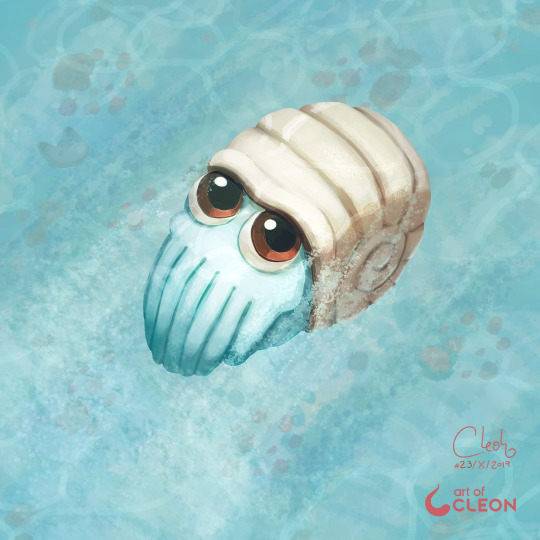
Inktober 2019 Day 23 - Omanyte
Today's theme is "ancient". I made Omanyte, a Rock/Water type Pokémon, swimming across the ocean a few million years ago. Curiosity is that it is inspired in the ammonoids, molluscs that appeared in the Devonian, 400 million years ago, and were extinct at the end of the Cretaceous, 66 million years ago (Source: Bulbapedia).
Check out other projects by clicking here: https://artofcleon.com
Facebook | Behance | Art of Cleon
#brazil#art#digital art#digital painting#artwork#illustration#concept art#art of cleon#photoshop#inktober#inktober 2019#fanart#pokemon#pokemon art#pokemon fanart#pikachu#nintendo#day 23#ancient#omanyte#ocean#kanto#water#rock
1 note
·
View note
Text
ammonoids and trilobites being extinct feels like a crime against me personally
1 note
·
View note